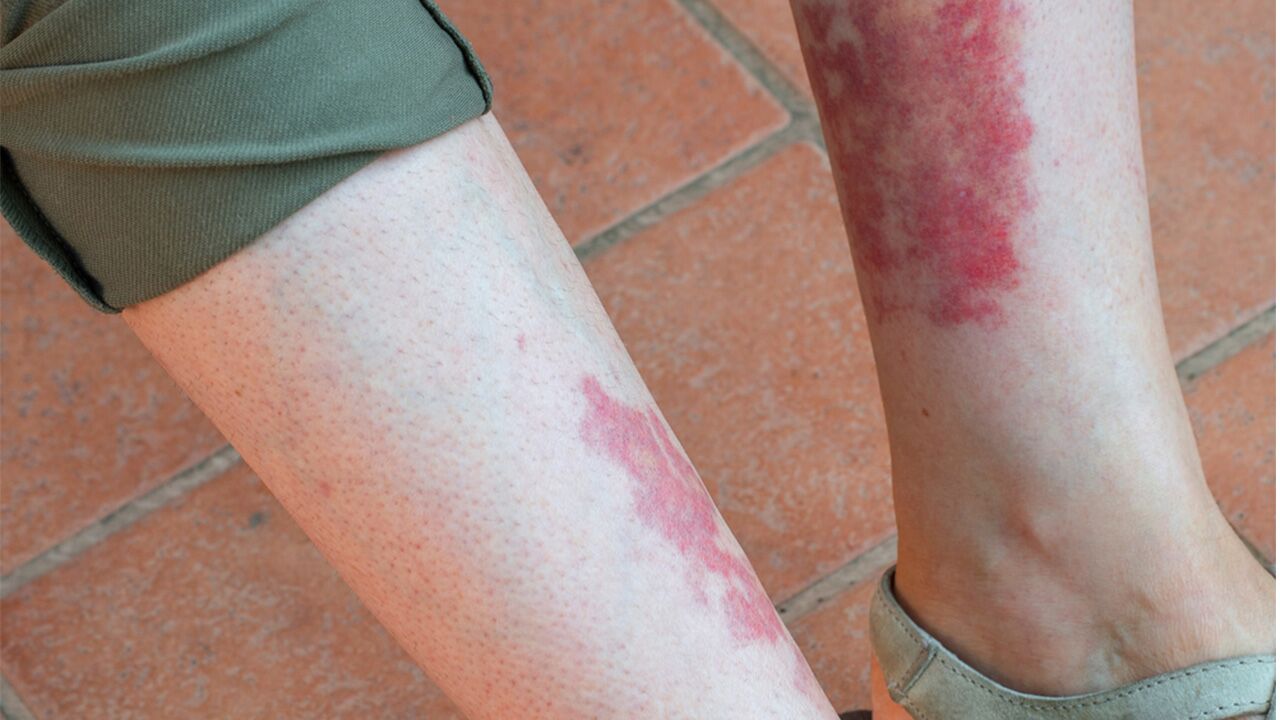Vasculitis: Signs, Symptoms, Causes, Treatment
 By: by Amino Science
By: by Amino Science

A potentially life-threatening condition in which blood vessels become inflamed, vasculitis refers to a group of rare diseases with disparate effects. While there are multiple types of vasculitis, the primary symptoms include changes in the walls of blood vessels, especially thickening, narrowing, weakening, and scarring. Without treatment, vasculitis patients may suffer serious organ and tissue damage.
Vasculitis can be acute (short term) or chronic (long lasting). Early detection and treatment is the best way to prevent this condition from impacting quality of life.
Types of Vasculitis
There are 20 different forms of vasculitis give or take. While they all account for blood vessel inflammation, they affect different organs, present with different symptoms, and require different types of medication.
- Behcet’s disease: Manifests as mouth and genital ulcers, as well as eye inflammation and skin rashes.
- Buerger’s disease: Associated with smoking, Buerger's disease impairs blood flow to the extremities and can damage skin tissue and lead to gangrene and skin infections.
- Central nervous system vasculitis: Affecting the blood vessels in the spine and brain, central nervous system vasculitis is associated with autoimmune diseases such as lupus, RA, and dermatomyositis, as well as viral and bacterial infections and other vasculitic disorders, including GPA and Behcet's.
- Cryoglobulinemia: With a possible connection to hepatitis C infections and paraproteinemias, cryoglobulinemia is marked by red spots on the lower extremities.
- Eosinophilic granulomatosis with polyangiitis (EGPA, previously called Churg-Strauss syndrome): This type of vasculitis affects the kidneys, lungs, peripheral nerves, skin, and heart and is linked to conditions such as asthma, nasal polyps, sinusitis, and elevated eosinophil counts.
- Giant cell arteritis: Formerly known as “temporal arteritis,” giant cell arteritis is the most common form of vasculitis among North American adults. Older adults between 70 and 80 years of age are the most at risk, but the disease can strike anyone over 50 with symptoms including headache, fever, and jaw and scalp pain.
- Granulomatosis with polyangiitis (GPA, previously known as Wegener’s granulomatosis): This type of vasculitis primarily affects the upper respiratory tract, lungs, and kidneys. GPA inflames the small and medium-sized blood vessels and causes tissue damage called granulomatous inflammation. Common symptoms are nasal congestion, frequent nosebleeds, shortness of breath, cough, joint pain, weight loss, and numbness and loss of function in the fingers and toes.
- Henoch-Schönlein purpura/IGA Vasculitis (HSP): A type of hypersensitivity vasculitis that affects the small blood vessels, HSP causes symptoms such as rash, joint pain and swelling, abdominal pain, blood in the urine, and/or kidney disease. It is thought to be brought on by an immune system attack that can be triggered by upper respiratory tract infections.
- Kawasaki disease: Most common in Japanese and Korean children under 5 years old, Kawasaki disease first strikes as a fever, and then as red eyes, a rash on the stomach, genitals, or chest, red or cracked lips, a sore throat, and swollen tongue, lymph nodes, hands, and feet.
- Microscopic polyangiitis: Affecting the entire body, this vasculitis is believed to be triggered by a faulty immune system response that causes tissue and blood vessel inflammation and damage. Kidney, skin, nerves, lungs, and joints can all be impacted.
- Polyarteritis nodosa: Inflammation of the small arteries and medium-sized blood vessels blocks the transport of food and oxygen to the body's vital organs, particularly the nerves, intestinal tract, heart, and joints.
- Polymyalgia rheumatica: Muscle pain and stiffness in the shoulders and hips are markers of this inflammatory disorder, which is often experienced in conjunction with giant cell arteritis.
- Rheumatoid vasculitis: A serious complication that afflicts people with chronic and severe rheumatoid arthritis (RA), rheumatoid vasculitis symptoms include small sores around the fingernails, a painful red rash, skin ulcers, damage to the nerves resulting in numbness and tingling, loss of function of the hands and feet, lack of blood flow that can cause gangrene of fingers or toes, stomach pain, cough, chest pain, heart attack, and/or a stroke.
- Takayasu’s arteritis: Most common in women of child-bearing age, this large vessel vasculitis can cause arterial blockages that trigger arm or chest pain, as well as high blood pressure that can bring on a cardiovascular event, such as a heart attack or stroke.

Vasculitis Symptoms
Vasculitis signs and symptoms vary based on the type of condition a patient is suffering from, though most involve decreased blood flow.
The symptoms of vasculitis differ upon the affected organs, with many patients experiencing fever, fatigue, headaches and other aches and pains, night sweats, and nerve problems. If vasculitis affects the skin, patients may experience rashes, discoloration, and ulcers. Vasculitis that affects the muscles causes muscle pain. Patients with vasculitis affecting the lungs may notice shortness of breath, while patients with heart vasculitis may develop congestive heart failure. Finally, vasculitis affecting the brain can lead to confusion, seizures, strokes, paralysis, and lightheadedness.
Vasculitis Causes
Doctors don’t know exactly what causes vasculitis. However, it’s believed that the condition results from genetic factors that cause the immune system to attack healthy blood vessel cells. When blood vessels bleed or become inflamed, the walls thicken, thereby limiting the flow of blood through the body. As a result, oxygen and nutrients are unable to reach bodily organs and tissues.
The following pre-existing conditions can increase one’s risk of developing vasculitis:
- Hepatitis B, hepatitis C, and other infections
- Blood cancers
- Immune system disorders like rheumatic diseases and lupus
- Taking certain drugs
Additionally, patients who smoke may be at an increased risk for vasculitis.
Diagnosing Vasculitis
A vasculitis diagnosis can involve a biopsy, an angiography, or a series of blood tests.
- Diagnosing small-vessel vasculitis: Physicians typically test for small-vessel vasculitis using a biopsy, which involves surgically removing a small sample of tissue.
- Diagnosing medium-vessel vasculitis: To diagnose medium-vessel vasculitis, doctors do a biopsy or take an angiography, which is an X-ray that checks for blood vessel abnormalities.
- Diagnosing large-vessel vasculitis: This type of vasculitis requires an angiography and often a biopsy, such as with giant cell arteritis that requires a biopsy of the artery in the scalp.
Other types of vasculitis, including Kawasaki disease and Behcet's, are diagnosed based on clinical findings versus a biopsy or angiography. Blood tests that check for antineutrophil cytoplasmic antibodies (ANCA) are useful for diagnosing GPA, microscopic polyangiitis, or EGPA.
Vasculitis Treatment
The goal of vasculitis treatment is to control inflammation and underlying conditions in order to minimize the effects of the disorder. Doctors may recommend maintenance therapy to prevent relapse. The drugs patients take and the timeline involved likely depends on the severity of the disease and what organs are impacted. While some patients experience many flare-ups, others are symptom-free for months or even years.
Corticosteroids are among the most commonly prescribed drugs for vasculitis. While prednisone and methylprednisolone are effective ways to control inflammation, they often result in serious side effects, including weight gain, bone thinning, and even diabetes. Doctors tend to prescribe the lowest steroid dose possible in order to keep side effects at a minimum. Another commonly prescribed drug, methotrexate (MTX) helps vasculitis patients by dampening the immune system response and encouraging remission.
In more severe cases, doctors may recommend surgical treatment for vasculitis. Some patients develop an aneurysm in the blood vessel wall that requires surgical intervention. Surgery may also be necessary for patients with blocked arteries.
Amino Acids and Heart Health
Researchers are just starting to understand the ways in which amino acids affect heart health. In a study of 200 women with healthy BMIs, doctors determined that the patients whose diets included the most amino acids also had the lowest blood pressure and least arterial stiffness. According to Dr. Amy Jennings of UEA’s Norwich Medical School, the project’s head researcher, the amino acids associated with the positive effects were glutamic acid, leucine, and tyrosine, all of which are from animal-based food sources. Doctors hypothesize that the blood pressure-lowering effect is due to a greater production of nitric oxide, which widens blood vessels and enables blood to flow through them more readily.
Studies show that taking L-arginine may help patients improve vascular health. Because the body converts L-arginine into nitric oxide, and NO improves circulation, individuals who consume more of this amino acid may enjoy benefits like:
- Reduced risk of angina, heart attack, and stroke
- Lowered blood pressure
- Enhanced brain function
- Improved sexual function
You can increase your L-arginine intake by eating more poultry, fish, nuts, and seeds, as well as consuming certain protein shakes and supplements. When it comes to the most effective amino acid supplement for increasing arginine levels in the body, it isn’t arginine itself.
In order to elevate arginine levels sufficiently enough to improve blood vessel health, you have to take doses that are so high, they can cause stomach upset. For this reason, our expert team of amino acid researchers recommend supplementing with a balanced amino acid blend that contains citrulline. Citrulline doesn’t cause stomach distress and increases arginine levels much more than the same amount of arginine can.

Up to 25% off Amino
Shop NowTAGS: conditions
Join the Community
Comments (0)
Most Craveable Recipes




 833-264-6620
833-264-6620



















